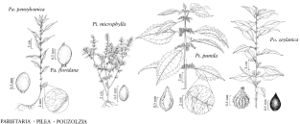Parietaria floridana
Gen. N. Amer. Pl. 2: 208. 1818.
Herbs, annual or short-lived perennial, 1-4 dm. Stems 10-20-branched, decumbent to ascending. Leaf-blades orbiculate to deltate, 0.7-2.7 × 0.5-1.7 cm, base truncate, rounded, or very broadly cuneate, apex smoothly attenuate or occasionally slightly acuminate. Flowers: involucral-bracts 1.5-2 mm; tepals ca. 1.5 mm, nearly equal to bracts. Achenes light-brown, symmetric, 0.5-0.8 × 0.3-0.6 mm or less, apex obtuse, mucro ±apical; stipe centered, short-cylindric, abruptly flared basally.
Phenology: Flowering winter–spring.
Habitat: Weedy places, around masonry, woodland and shrub borders, shell mounds, sandy beaches, roadsides, Atlantic and Gulf coastal plains
Elevation: 0-30 m
Distribution

Del., Fla., Ga., La., Miss., N.C., S.C., Tex., Mexico, West Indies, South America
Discussion
Parietaria praetermissa has been misidentified as P. floridana by some authors.
Selected References
None.
Lower Taxa
None.
... more about "Parietaria floridana"
stipitate +
symmetric +
light-brown +
dehiscing +
basifixed +
truncate +
arranged +
rounded +
pistillate +
bisexual +
Weedy places, around masonry, woodland and shrub borders, shell mounds, sandy beaches, roadsides, Atlantic and Gulf coastal plains +
straight +
absent +
lacking +
hooked +
stinging +
Present +
axillary +
spikelike +
dotted +
equal +
0.5cm;1.7cm +
simple +
alternate +
apical +
persistent +
hypogynous +
accrescent +
absent +
staminate +
bisexual +
Gen. N. Amer. Pl. +
1818 +
longitudinal +
absent +
10-20-branched +
sessile +
deciduous +
centered +
absent +
absent +
Parietaria floridana +
Parietaria +
species +
distinct +
ascending +
hypogynous +
1.5 cm15 mm <br />0.015 m <br /> (?) +
equal +
pubescent +
small +
